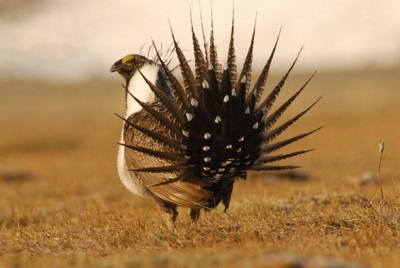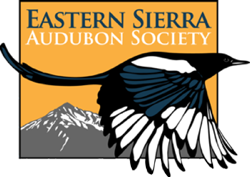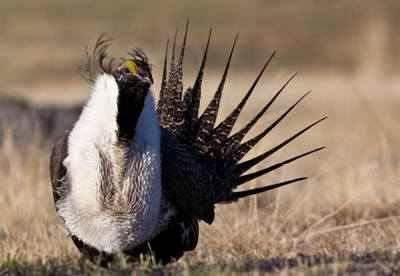Birds of Interest: Greater Sage-Grouse
Introduction
The Eastern Sierra is home to the Bi-State Distinct Population Segment of Greater Sage-Grouse, recently proposed as Threatened under the Endangered Species Act. Birders are obviously interested in seeing the annual spectacle of lekking, where the males stake out areas to make their showy display and females choose males to mate with.
Many of the lekking sites are on Los Angeles Department of Water and Power (LADWP) land, and as such, Eastern Sierra Audubon has collaborated with LADWP and other local agencies to develop a policy regarding access to DWP land in the Eastern Sierra for viewing Greater Sage-Grouse. This policy includes seasonal public access restrictions, viewing permit information and viewing guidelines to protect the birds and their habitat.
The Los Angeles Department of Water and Power’s efforts to protect the Greater Sage-Grouse, and therefore the development of this policy, have been supported by a multi-party collaboration that has included the Bureau of Land Management, California Department of Fish and Wildlife, Eastern Sierra Land Trust and the Eastern Sierra Audubon Society. This collaboration was supported in part by a grant from California Audubon to respond to the pressures on sage-grouse due to large numbers of people who wish to observe the birds and their behavior.
It is our hope that bird enthusiasts will heed this policy, and share it among themselves in order to protect the declining populations of this keystone species. If there are any questions regarding this matter, please contact: Bill Deane, Watershed Resources Specialist, Los Angeles Department of Water and Power, 300 Mandich St., Bishop, California. 760 873 2283, bill.deane@ladwp.com.
Click here (or the image at right) to see the Sage-Grouse brochure produced by Eastern Sierra Land Trust, in partnership with Eastern Sierra Audubon, LADWP, California Fish and Wildlife, Bureau of Land Management, and the Inyo National Forest.
Greater Sage-Grouse Lek Access Policy and Viewing Guidelines
Background | Lek Access Policy | Lek Viewing Guidelines
November 2014: The Los Angeles Department of Water and Power (LADWP) has developed a Greater Sage-Grouse Lek Access Policy and Lek-Viewing Guidelines for City of Los Angeles property (City) in Mono County, California. The Lek Access Policy defines when sage-grouse leks on City-owned property are accessible to the public, and the process by which sage-grouse leks can be viewed. In addition, LADWP has collaborated with the Bureau of Land Management (BLM), the California Department of Fish and Wildlife (CDFW), the Eastern Sierra Land Trust (ESLT) and the Eastern Sierra Audubon Society (ESAS) to develop Lek Viewing Guidelines for Sage-Grouse on City-owned lands as well as lands managed by other agencies. These policies and guidelines have been developed in order to minimize impacts from vehicular disturbance and recreation to Greater Sage-Grouse during their breeding season.
Background Information

Greater Sage-Grouse, photo by Donna Willey
The Greater Sage-Grouse that occur on City lands are part of the Bi-State population of Greater Sage-Grouse. The Bi-State area includes the majority of Mono County, the White Mountains in Inyo County, and portions of several counties in western Nevada. The Bi-State population of Greater Sage-Grouse is a distinct population segment (DPS) of sage grouse and is proposed for listing as threatened under the Federal Endangered Species Act.
In spring, male sage-grouse gather together to perform courtship displays on breeding grounds called leks. Leks are typically in meadows or in relatively open areas within sagebrush habitat where males perform courtship displays to attract females. Lek areas are usually surrounded by sagebrush-grassland habitats which are used for escape, cover, nesting, and foraging. The proximity, configuration, and abundance of nesting habitat are key factors influencing lek locations.
An extensive road and trail network occurs throughout the Bi-State area and roads are known to result in both direct and indirect impacts to sage-grouse. On City lands, essentially all lek areas are accessible to vehicles during average spring conditions along well-maintained roads. Vehicular access is currently controlled at several lek sites by other local land management agencies, preventing impacts directly to the lek areas during the breeding season. Sage-grouse lek-viewing is a popular annual activity for wildlife enthusiasts, including many Audubon and bird tour groups. In Mono County, access to leks on City-owned lands is currently unrestricted and unregulated. Visitation to the leks is anticipated to increase due to a number of factors including the increased availability of electronic information regarding the specific location of leks, the increased public awareness of the species due to the legal status, and increases in the number of visitors to the area, etc. By developing the Lek Access and Lek-Viewing Policy, LADWP is implementing components of its Greater Sage-Grouse Conservation Strategy (2014) and Owens Valley Land Management Plan (2010) and addressing potential road and recreational impacts to Greater Sage-Grouse.
Lek Access Policy
The LADWP will enact the following Lek Access Policy on City-owned property in order to manage human disturbance and minimize impacts to the Greater Sage-Grouse. This policy has been created to help protect and maintain the natural resources that occur on City lands and ensure continued enjoyment of these resources in an appropriate manner for years to come.
The LADWP’s Greater Sage-Grouse Lek Access Policy consists of the following components:
- Seasonal closure prohibiting access to sage-grouse habitat areas and leks south of Benton Crossing Road during the peak breeding period: March 1 – last Saturday in April. No public access during this time period.
- Public access will be allowed starting the last Saturday in April. Greater Sage-Grouse leks may be viewed by individuals without receiving prior written permission. Visitors must follow the “Lek Viewing Guidelines” and any other guidelines posted on-site.
- Written Permission is required from LADWP for the following activities on City of Los Angeles property:
- Photography of Sage-Grouse at leks
- Organized field trip to leks – both commercial and non-commercial
- Any research or monitoring on City-owned property
- To request permission, please contact Bill Deane, Watershed Resources Specialist, Los Angeles Department of Water and Power, 300 Mandich St., Bishop, California. 760 873 2283, Bill.deane@ladwp.com.
- When requesting permission for specific activities, please provide the following information: contact information of group leader, estimated number of participants and vehicles anticipated to be onsite, and dates of the activities. Please allow at least 60 days advanced notice in order to process requests.
Lek-Viewing Guidelines
The LADWP will enact the following Lek-Viewing Guidelines on City-owned property in order to manage human disturbance and minimize impacts to the Greater Sage-Grouse. These guidelines have been developed through a collaborative process with the BLM, CDFW, ESLT, and ESAS and have incorporated standard lek viewing guidelines established throughout the range of the Greater Sage-Grouse.
LADWP’s Lek Viewing Guidelines consists of the following components:
- Always practice ethical and responsible wildlife viewing from designated viewing areas
- Remain a minimum of 300 yards from any sage-grouse whenever possible
- Do not drive near or onto any lek or meadow area.
- Minimize sound and visual disturbances when in the vicinity of lek areas. Turn off vehicle lights and engines as quickly as possible, and stay in your vehicle when possible to view a lek, whenever within 300 yards of sage-grouse.
- Leave pets at home.
- Do not report, post, or record the location of any Sage Grouse lek via the internet to any electronic mailing list or online birding checklist programs such as ‘eBird’.
The Lek-Access Policy and Lek-Viewing Guidelines may be modified, as needed to ensure conservation strategy and land management objectives are being met. For questions regarding this policy, please contact Bill Deane, Watershed Resources Specialist at 760-873-2283, Bill.deane@ladwp.com.
Click here to download or print this Sage-Grouse Lek Viewing Policy as a PDF file (3 pages)
Click here to view or download the full-color Sage-Grouse brochure(pdf)




